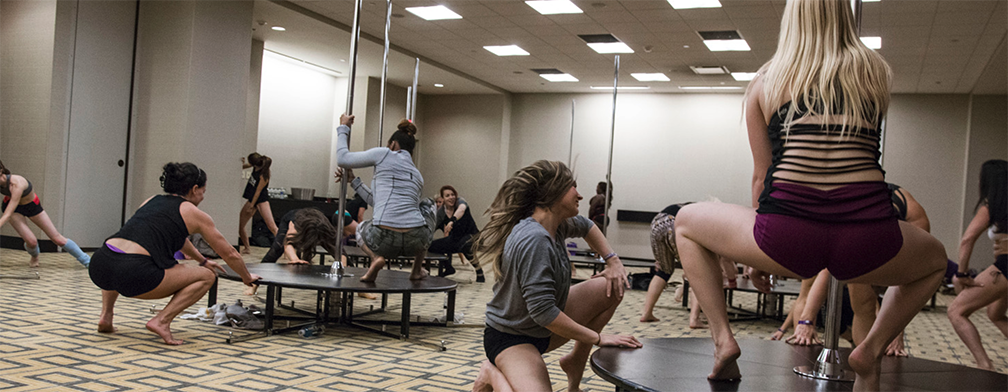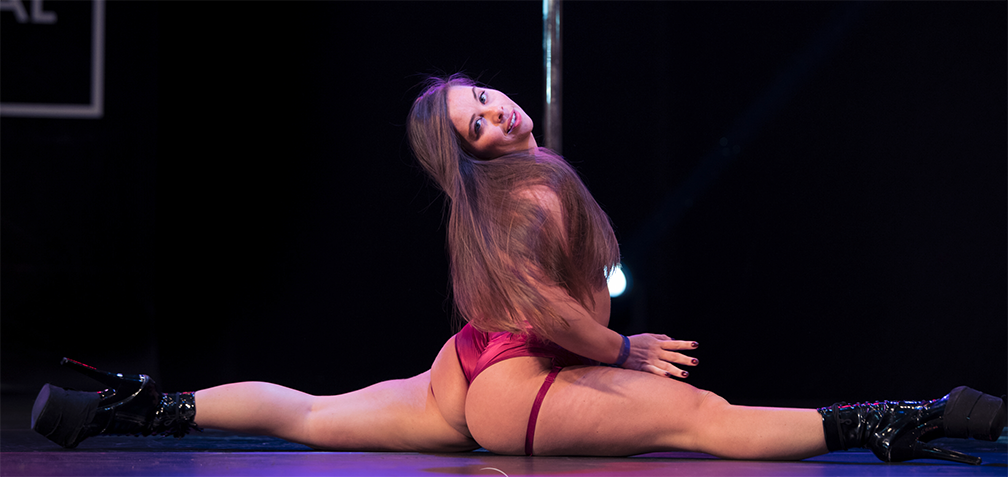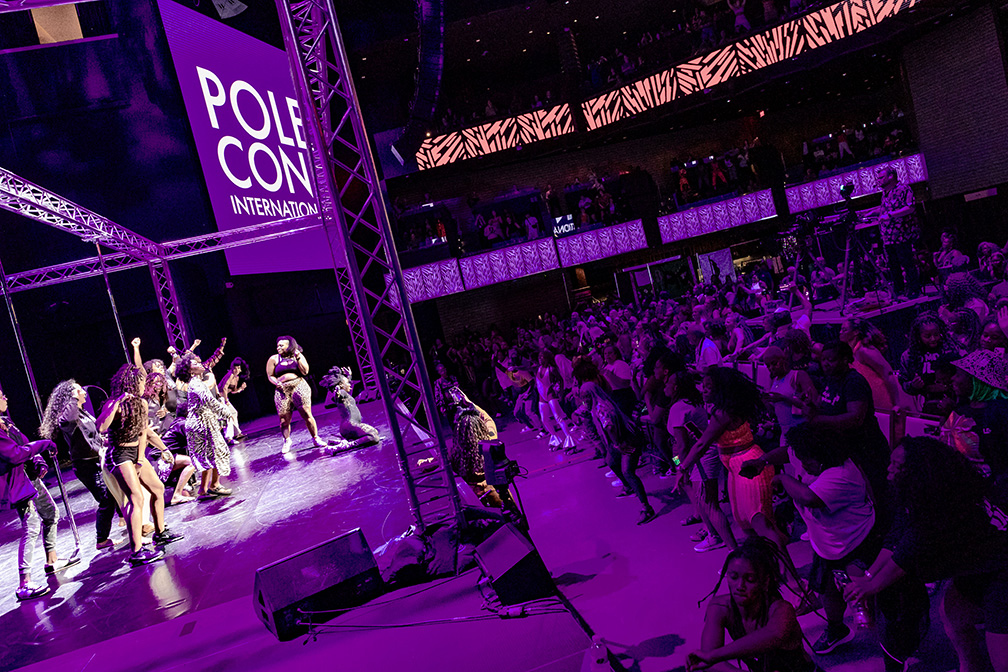Historically PoleCon has held workshops that were labeled: Beginner or All Levels Intermediate (basic climbing…

Becoming a Touring Pole Star: Step 1, Create Your Menu
(originally published in the Bad Kitty blog, republished with permission)
So you want to a touring pole star but aren’t sure how to start? There’s no official process to going on tour. If you think you’re a great instructor with something unique to offer, maybe you want to branch out from your home studio or maybe you don’t. The first step to making the leap to become a touring pole star teaching workshops in glamorous locations all around the world is the create what’s known in the industry as your “menu.”
As a previous studio owner and through running the International Pole Convention (PoleCon), I have seen a lot of different menus in the past few years. Some are awesome and some need a little bit more polish. I’ve had several people ask me to demystify process is for teaching at PoleCon or anywhere other than their home studio and while there is no official process that guarantees success (see Section “Getting Picked” for some thoughts to consider) the first step is having a compelling offering that is clear, consistent, and communicative.
Your menu contains all the basic information needed for a studio owner or an event manager/booker needs to understand who you are, what you do, and most importantly, what you are going to add to the experience for their studios or event(s). You may also want to have a website, a logo, merchandise and a whole host of other items that help market you and your unique offering, but at a minimum and to start – you need a menu.
How to Physically Create Your “Menu”
A menu can be any size but should be concise. My favorite menus are a few pages or slides long and are in a “standard” size such as a 8.5×11 (if you’re in the US) or A4 (if you’re not) paper so I can print it out or read it on my phone. It can be a Word document, a website (or a secret/hidden webpage works if you want to control access to that information), a PowerPoint presentation, or a PDF of any of the above source materials. Generally you want your menu to be small enough, byte-size to email (if an attachment) and not include any linked images or crazy fonts that might not come across right on someone else’s computer. PDF is a good, safe bet to send rather than a native Word or PowerPoint file and for ways to use PowerPoint as a powerful marketing tool, check out this blog previously created for generating fliers. You could do use it the same way to create your menu. If you’re a Mac user, the same theory applies to KeyNote.
Make sure you have good, clear photos. They don’t have to be officially professional, but it does help. If you’re having trouble designing your menu or don’t have any of the software already listed, try a tool like Canva which is entirely online and mostly free. Always ask a friend to proof-read your menu before you send it out – they can help catch obvious spelling mistakes or other small formatting issues that could make you appear less professional.
Create a Relevant Bio
Don’t presume people know who you are. There are so many amazing pole dancers, so many competitions, so many studios, so many reality-TV shows that it is hard to keep up with whomever is the newest, hottest pole dancer. If you have won a bunch of awards, write them down! Include the year, the title, and the organization. If you haven’t won a bunch of awards but have done a bunch of training and have years of ballet or a background in kinesiology for example, write that down too also including the years studied or when you were certified/trained and if relevant, by whom. If you have a methodology or teaching ethos that makes you unique make sure it’s referenced in your bio. You might want to have a separate section devoted to that if it is a differentiator to your offering.
If you are just transitioning into this career it might not be relevant to include that you’re also a PMI-certified Project Manager or that you passed the bar exam in New York. Or it might be. Your bio should tell the story that you want people to know. For instance, we have several former strippers in our community and for some that is something they want to advertise and is part of their brand while for others it isn’t relevant.
Also include links to your social media, performances or class promo videos, website (if you have one), and contact information. If you are working through an agent, include their information too.
Why Should They Choose You
Either in your bio, or in a separate section literally labeled something like “Why Should You Hire Me” explain what is so unique about you. Do you have a specialty helping plus-size students; men; students with chronic injuries, illnesses, or disabilities? Do you have a particular style such as a “drill sergeant” or are you more like a “coach”? If I don’t yet know you personally (following each other on Instagram doesn’t count) then don’t presume I or anyone else knows what makes you special. And even if I do presume what makes you special – maybe I’m making the wrong presumption. Maybe I think you’re all about sexy pole and really you have developed a specialty for teachings kids and have developed an entire curriculum you want to tour on! Don’t let people presume – clearly tell them why you are unique and awesome and what you bring to their studio or their event.
Develop Specific Workshop Options
Using your unique offering/why choose you as a basis; develop at least three workshop options with at least one non-pole (if you’re focusing on pole) option. Consider giving each workshop a similar title if they are variations on the theme of your methodology or your personal brand. For instance, Bad Kitty ® Brand Ambassador Samantha Star offers several workshops with the word “Ninja” in it. Lindsey Lithe uses her last name in many of her workshop titles such as “Spiral Lithely” to show her uniqueness and clear branding.
After the title, be very clear about the level of the workshop and what requirements are needed to be successful. For instance, if you think the workshop should be an “Intermediate” level, what does that mean? Inverting from the floor? Shouldering mounting from the floor? Aerial handspring? Be very clear about what you expect students to already posses.
If you are teaching a tricks-based workshop, be specific about the tricks you intend to teach and then in your workshop actually teach those tricks. The biggest complaint I hear from students after a workshop during PoleCon is they thought they were signing up to do trick X and never did it. There are many reasons why a pole star might choose not to do a trick including their own level of injury or tiredness or how capable the actual class turned out to be (i.e., requirements said aerial inversion and students could not climb). Do your best to be specific on what things you will cover and what people will achieve after your class and then deliver.
Create Some Terms and Conditions
For most studio situations, pole stars specify their contractual requirements or terms and conditions, which may include:
- Cost per head per workshop (i.e., $30)
- Required number of workshops per studio (i.e., minimum 2)
- Minimum number of students (i.e., minimum 5 per workshop)
- Maximum price a studio can put “on top” of the cost (i.e., $15)
- Pricing for Private classes (i.e., 1 person 60 min = $80, 2 people = $120, 3 people = $150)
- Accommodation requirements (i.e., paid hotel or a guest room)
- Exclusivity requirements (i.e., not teaching within a XX mile radius)
- Marketing requirements (i.e., advertising once per week on Instagram)
- Cost to cancel and timeframe to cancel (and not incur the cost) (i.e., if canceled less than 14 days in advance, 20% fees at minimum apply)
- Other stipulations like insurance requirements, ways to be paid (check, PayPal, Venmo, in the local currency etc.), and allergies (particularly important if you’re allergy to certain metals or pets)
For most event situations, since there are so many pole stars, there is often one price and one level of stipulations. It doesn’t hurt in either scenario to be flexible about your basic terms if appropriate. Maybe you really want to go to this particular location/studio for other reasons so you relax your minimum number of students, or perhaps this studio has a policy of doing a cost-share arrangement or package pricing to entice students to take more than one workshop. An open dialog is useful however, this is a business and you should know how far you’re willing to negotiate and what things you are not willing to negotiate.
Getting Picked
You might have an awesome menu, a strong bio, a very specific offering, and still not get picked to teach workshops at the studio or at the event.
Studios know their students best and they might decide that what you’re selling isn’t appropriate or wouldn’t sell well. Or they might not like your terms and conditions. Try opening a dialog to get feedback either on how you could improve your offering and your materials or if they have ideas where you might be a more appropriate workshop leader. In large metro areas some studios specialize and while you might be too sexy for Studio A, you might be perfect for Studio B right down the street.
For events, at least from my perspective, I’m concerned about offering a variety of things to my diverse attendees AND also confirming that this person I’m hiring will sell well. If I give a spot to someone who is an awesome teacher but not a great marketer then they might not fill the workshop. Conversely, if they are a great marketer but get terrible reviews then I have angry/upset attendees and I’m less likely to book them again. Events are much more expensive to put on then the costs for a studio typically to put on a workshop so event organizers can get picky about who gets workshop slots.
While I can’t speak for all event organizers, I can tell you what I do. I look at the overall uniqueness and breadth of styles – do I have sexy, sporty, all body types, equal representation from different groups, etc. – and also look at metrics like number of social media followers. I lurk in many Facebook groups and see which pole stars get great reviews from students and which have specific complaints.
You don’t have to have a huge social media following, a bunch of contracts to be a brand ambassador for brands, or have won any awards. You do have to be clear, consistent, and PROFESSIONAL in your materials and in your interactions.
Having a Contract
Always have a contract. Pole is generally a friendly industry and is many people’s second and third jobs. Because of this, sometimes “general business rules” can get a bit too relaxed and in the worst-case situations people can get taken advantage of, not paid, and generally not have their expectations met. While laws across state and country lines can differ wildly and actual litigation is costly, having a contract that stipulations all terms and conditions that all parties agree to is a basic precautionary measure. Don’t wait until you’re sleeping in someone’s guest room to double check your workshop minimums or find out that you can’t sell the merch you were expecting to pay your train ticket back home. More can definitely be written about this topic!
Actually Starting
Start networking and asking friends for recommendations for studios to reach out to or post some tentative feelers on social media to see where might be a good area for you to start touring. Then actually reach out to these studios owners and/or events by creating a professional email and attaching your professional menu. Student owners and event organizers are busy people so if you haven’t heard from them in a few days, email again to confirm they received your email and if you can answer any questions about your unique offering. Try not to bombard their email, their Facebook, AND their DM on Instagram. Have some patience but do follow up.
Be professional, be clear, and be very specific about who you are and why you are uniquely awesome. Be creative and engaging and definitely make sure you have no spelling mistakes and you’ll be on your way to becoming a touring pole star with your first professional menu!
Latest posts by Colleen (see all)
- Updating Workshop Levels at PoleCon (2025 and Beyond) - July 19, 2024
- PoleCon Exhibitor Spotlight: Flaaluhs - July 5, 2024
- Teacher Tip: How to improve your verbal cues - June 28, 2024


